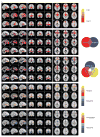Common and distinct networks underlying reward valence and processing stages: a meta-analysis of functional neuroimaging studies
- PMID: 21185861
- PMCID: PMC3395003
- DOI: 10.1016/j.neubiorev.2010.12.012
Common and distinct networks underlying reward valence and processing stages: a meta-analysis of functional neuroimaging studies
Abstract
To better understand the reward circuitry in human brain, we conducted activation likelihood estimation (ALE) and parametric voxel-based meta-analyses (PVM) on 142 neuroimaging studies that examined brain activation in reward-related tasks in healthy adults. We observed several core brain areas that participated in reward-related decision making, including the nucleus accumbens (NAcc), caudate, putamen, thalamus, orbitofrontal cortex (OFC), bilateral anterior insula, anterior cingulate cortex (ACC) and posterior cingulate cortex (PCC), as well as cognitive control regions in the inferior parietal lobule and prefrontal cortex (PFC). The NAcc was commonly activated by both positive and negative rewards across various stages of reward processing (e.g., anticipation, outcome, and evaluation). In addition, the medial OFC and PCC preferentially responded to positive rewards, whereas the ACC, bilateral anterior insula, and lateral PFC selectively responded to negative rewards. Reward anticipation activated the ACC, bilateral anterior insula, and brain stem, whereas reward outcome more significantly activated the NAcc, medial OFC, and amygdala. Neurobiological theories of reward-related decision making should therefore take distributed and interrelated representations of reward valuation and valence assessment into account.
Copyright © 2010 Elsevier Ltd. All rights reserved.
Figures



References
Publication types
MeSH terms
Grants and funding
LinkOut - more resources
Full Text Sources
Medical
Miscellaneous

